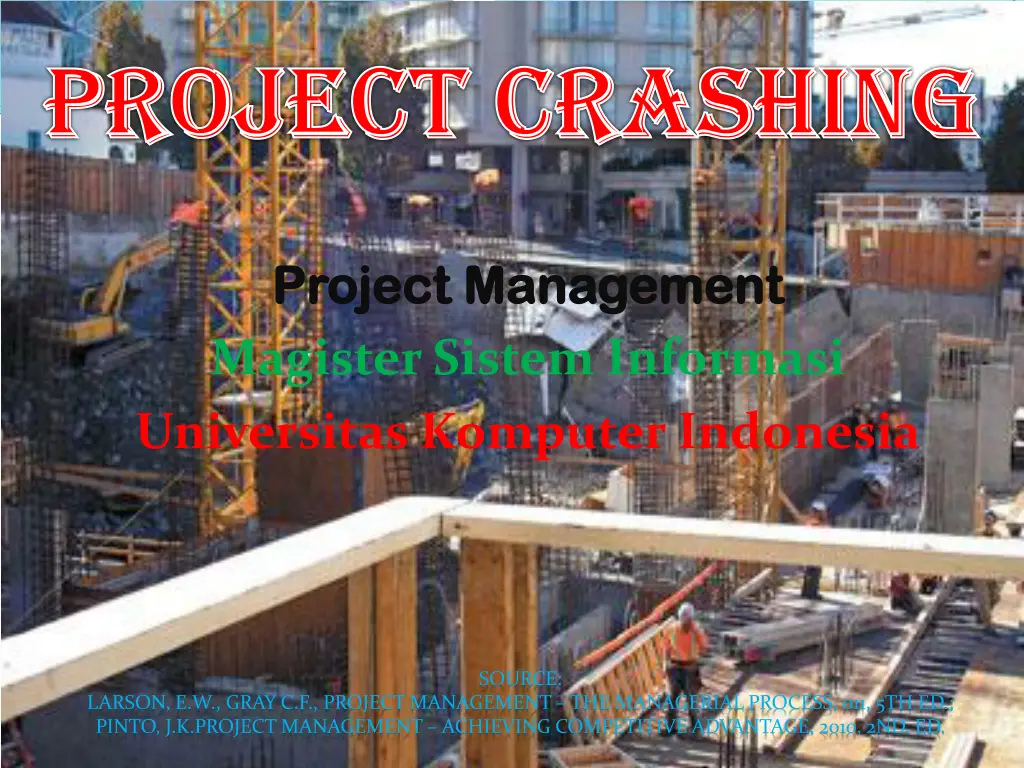
Accelerating Your Project: Crash vs. Normal Time-Cost Trade-Offs
Learn about the concept of crashing a project to expedite development and reach completion earlier. Explore reasons to crash a project, options for accelerating activities, time-cost trade-offs, costs of crashing, and an example calculation to determine optimal candidates for crashing activities.
Uploaded on | 1 Views
Download Presentation

Please find below an Image/Link to download the presentation.
The content on the website is provided AS IS for your information and personal use only. It may not be sold, licensed, or shared on other websites without obtaining consent from the author. If you encounter any issues during the download, it is possible that the publisher has removed the file from their server.
You are allowed to download the files provided on this website for personal or commercial use, subject to the condition that they are used lawfully. All files are the property of their respective owners.
The content on the website is provided AS IS for your information and personal use only. It may not be sold, licensed, or shared on other websites without obtaining consent from the author.
E N D
Presentation Transcript
Project crashing Project crashing Project Management Project Management Magister Sistem Informasi Universitas Komputer Indonesia SOURCE: LARSON, E.W., GRAY C.F., PROJECT MANAGEMENT THE MANAGERIAL PROCESS, 011, 5TH ED.; PINTO, J.K.PROJECT MANAGEMENT ACHIEVING COMPETITIVE ADVANTAGE, 2010, 2ND. ED.
Project crashing Project crashing At times it is necessary to expedite the project, to accelerate development to reach an earlier completion date. The process of accelerating a project is referred to as crashing. Crashing a project directly relates to resource commitment. The more resources we are willing to expend, the faster we can push the project to its finish.
Reasons to Crash a Project The initial schedule may be to optimistic. 1. 2. Market needs change and the project is in demand earlier than anticipated. 3. The project has slipped considerably behind schedule. 4. The contractual situation provides even more incentive to avoid schedule slippage.
Options for Accelerating Activities Improving the productivity of existing project resources. 2. Changing the working method employed for the activity, usually by altering the technology and types of resources employed. 3. Increasing the quantity of project resources, including personnel, plant, and equipment. 1.
Time-Cost Trade-Offs for Crashing Activities Crashed Point Crashed Cost Normal Point Normal Crashed Normal Time
COST OF CRASHING Crash Cost Normal Cost Slope = ------------------------ Normal Time Crash Time
EXAMPLE Calculate the cost of crashing project activities, suppose the normal activity duration of activity X is 5 weeks and is budgeted cost $12,000. The crash time for this activity is 3 weeks and is expected to cost $32,000.
Crashing a Project (Example) Suppose we had a project with only eight activities, as ilustrated in the next table. The table also shows our calculated normal activity durations and costs and crashed durations and their costs. We wish to determine which activities are the optimal candidates for crashing. Assume the project cost listed include both fixed and variable costs for each activity.
Crashing a Project (Example) Activity Normal Crash Duration Cost Duration Cost A 5 days $ 1,000 3 days $ 1,500 B 7 days 700 6 days 1,000 C 3 days 2,500 2 days 4,000 D 5 days 1,500 5 days 1,500 E 9 days 3,750 6 days 9,000 F 4 days 1,600 3 days 2,500 G 6 days 2,400 4 days 3,000 H 8 days 9,000 5 days 15,000 TOTAL COST= 22,450 $ 37,500
Cost of Crashing Each Activity Activity Crashing Cost (per day) A $ 250 B 300 C 1,500 D 0 E 1,750 F 900 G 300 H 2,000
EXERCISE -1 You are considering the decission of whether or not to crash your project. After asking your operation manager to conduct an analysis, you have determined the crash activity duration and costs, shown in the table below (assume all activities are on the critical path): Activity Normal Crashed Duration Cost Duration Cost A 6 days $ 1,000 4 days $ 2,000 B 5 days $ 2,500 5 days $ 2,500 C 3 days $ 800 2 days $ 1,200 D 7 days $ 3,500 3 days $ 7,000 E 2 days $ 500 1 day $ 5,000 F 5 days $ 2,000 4 days $ 3,000 G 10 days $ 5,000 6 days $ 6,300 a. Calculate the per day cost for crashing each activity b. Which are the most attractives candidates for crashing? Why?
Exercise 2 - Network Model C F A 5 D G I B E H
EXERCISE -2 (Questioned) Given the data and information that follow, compute the total direct cost for each duration. If the indirect costs for each project duration are $90 (15 time units), $70 (14), $50 (13), $40 (12), and $30 (11), compute the total project cost for each duration. What is the optimum cost-time schedule for the project? What is this cost? Act. Crash cost (slope) Maximum crash time Normal time Normal cost A 20 1 5 50 B 60 2 3 60 C 0 0 4 70 D 10 1 2 50 E 60 3 5 100 F 100 1 2 90 G 30 1 5 50 H 40 0 2 60 I 200 1 3 200
Solving Exercise using Win QS - Example File New Problem Fill: Problem Title, Number of Activities, & Time Unit Klik: Deterministik CPM Klik: Normal Time, Crash Time, Normal Cost, Crash Cost OK
Solving Exercise using Win QS - Example Input data
TERIMA KASIH TERIMA KASIH
